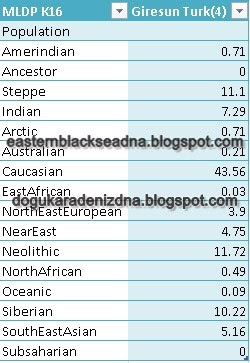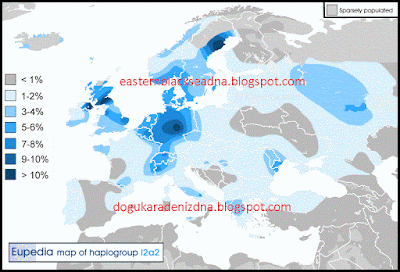Hi, in this week’s article I am going to make comparisons of
the peoples shared in the blog. I am going to share various comparisons and
dendrogram results.
The autosomal results in the article have been obtained using the MDLP K16 calculator and the dendrograms have been generated based on those results.
Let me start with the dendrograms;
When I group Armenians and Hemshins separately;
After the dendrogram results now I am going to touch upon
the divergent characteristics of these peoples;
Trabzon Greek - Trabzon Turk: No difference can be discerned
between these two groups whether in the haplogroups or in the autosomes, it can be seen that the reason for the differentiation is the difference in religion.
Armenian - Hemshin: When we investigate the small
differences it can be seen that the ratio of Caucasian (CHG, i.e.,
hunter-gatherers of the Caucasus, hunter-gatherers found in the Caucasus 13 thousand
years ago) in Hemshins is a bit higher than in Armenians (mostly western
Armenians have been used for this chart, Armenians in Armenia or in further
north are probably closer to the Hemshin average), other than this, the small increase
in Steppe (people of the Bronze Age European steppe) in Hemshins and the small
increase in Northeast European in Armenians are among the differences found.
Georgian - Laz: In this comparison there are some differences
which may disturb our preconceptions. The first thing that sticks out is the
highness of the Indian ratio in Georgians. Indian here refers to the SCA (South
Central Asia) connection, i.e., the degree of relation with Iranic peoples. The
difference in Northeast European also sticks out, while the Laz do not have any
northeastern European connection at all Georgians show some connection, the
reason behind this may be the colonies founded in Georgia. Another important
difference is the higher level of Neolithic (Anatolian Neolithic) in the Laz
than in Georgians, which means the Laz have more Anatolian connection.
Trabzon (Greek and Turk) - Cappadocian Greek: I deal with
this comparison to see the differences between two groups that are relatively
more distant geographically speaking. The first thing that sticks out is the
relative increase in Indian (SCA) in Trabzon, other than that, an increase in
the levels of Northeast European in Cappadocia sticks out, more detailed
studies are needed to explain the reasons of this but my guess is that there is a
relative increase related to the Indo-European groups coming to Anatolia in
ancient times. The most salient difference is seen in the Neolithic component,
Neolithic is high in Cappadocia relative to Trabzon. The reason for this is the
proximity of Cappadocia to the Anatolian Neolithic region and the location of
Trabzon in the Caucasian (CHG) region. There is no discernible difference other
than the ones I have mentioned.
Laz - Armenian: To clarify the difference I am using the Armenian average excluding Hemshins. Among the most salient ones is the
increase of Steppe in the Laz and the increase of Indian (SCA) in Armenians.
The Caucasian (CHG) ratio is higher in the Laz than in Armenians. Also
Armenians stick out with their higher Near East and Northeast European ratios.
Trabzon (Greek and Turk) - Laz: The Laz have higher Steppe
ratio and their Indian (SCA) ratio seems to be higher with a small difference,
while Caucasian (CHG) is higher in the Laz it is lower in Trabzon. Again, while
no Northeast European is discernible in the Laz, in Trabzon we see a relatively
higher ratio of it. In terms of the Near East ratios Trabzon is a bit higher
than the Laz, in Neolithic Trabzon possess a higher ratio than found in the
Laz.
Dersim Alevi - Giresun Turk - Other: Dersim and Giresun differentiate from the
others with some of their differences, the high East Eurasia ratios stick out
in Giresun, this seems to be connected to the Oghuz groups coming to Anatolia
from Asia. As for Dersim Alevis, their high Indian (SCA) ratios pull them
towards Iran from Anatolia.
Conclusion: The Anatolian origins of the peoples I have
mentioned are in a degree that makes all of them basically close to each
other. The principle differences of these peoples other than the differences I
have enumerated here are seen in the Y-DNA, in regard to this I had shown the
Y-DNA ratios of the peoples of the eastern Black Sea region, for the other
peoples, some Y-DNA studies about them can be accessed on the Internet. I hope I
have managed to shed light on some things.
Amerindian - a
component, which is modal (i.e has a peak) in various native American groups of
North and South America, as well as in ancient DNA of Native Americans (Clovis,
Kennewick man, etc).
Ancestor - an
archaic component, detected in modern African Pygmy populations (such as
Mbuties and Biaka) and Khoisan hunter-gatherers.
Steppe - a
component which was sourced from ancient genome of European Bronze Age
pastoralists: it roughly approximates levels of ancient North Eurasian
hunter-gatherers' heritage, which was subsequently shown to have an influence
in later eastern hunter-gatherers and to have spread into Europe via an
incursion of Steppe herders beginning 4,500 years ago.
Indian - a
component of ancestry harboured by populations of Indian subcontinent
Arctic - a
component displayed in genomes of Eskimo Inuits from Greenland and shared with
Siberian Chukchis/Koryaks.
Australian - a
component of aboriginal ancestry assigned to Australian aborigens.
Caucasian - a
major component of ancestry of modern inhabitants of Caucasus, Iran and
northern Indian : it was derived
from genomes of mesolithic Caucasian Hunter-gatherers: a major ancestral
component linked to CHG was carried west and east by migrating herders from the
Eurasian Steppe.
EastAfrican - a
very dilluted component being inherited specififically from ancient inhabitants
of Ethiopia and African Horn
NorthEastEuropean
- a fancy moniker for a dominant type of ancestry in North-Eastern Europe based
on older type of ancestry (WHG, west European Hunter-Gatherer), today this type
of ancestry peaks in the Baltic region and Scandinavia
NearEast - a
component harboured and later carried by ancient populations of Near East, in
our time it reaches the maximum among Bedoins and Saudi Arabians; the component
seems to carry an excess of Eurasian Basal component relative to Neolithic
component.
Neolithic - a
component, modeled on genomes of first neolithic farmers of Anatolia (West
Asia), these farmers from West Asia migrated to Europe during the Neolithic and
carried this component with them.
NorthAfrican - a
local component of ancestry found in North Africans: this local North African
genetic component is very different from the one found in the populations in
the south of the Sahara (Subsaharian component, see below).
Oceanic - a
component of aboriginal ancestry assigned to aborigens of Melanesia and
Papua-New-Guinea.
Siberian - a
component, which is rougly ascribed to Central Siberian (found at highest
frequency in Nganasan)
SouthEastAsian -
a dominant component of South East Asians: being highest among the Dai,
Cambodians, Lahu and Malay, this is the most common East Asian component among
South Asians.
Subsaharian - a
main component of ancestry seen in Yoruba, Mandenka and Luhya populations.













































